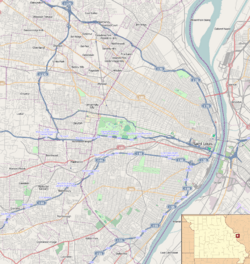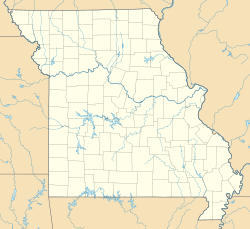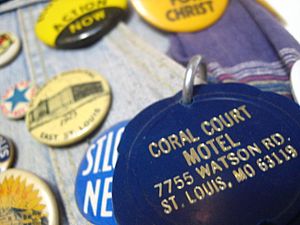Coral Court Motel facts for kids
| Coral Court Motel | |
Quick facts for kids 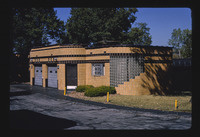 |
|
| Hotel facts and statistics | |
|---|---|
| Address | |
| Opening date | 1942 |
| Closing date | 1993 |
| Developer | John Carr |
| Architect | Adolph L. Struebig (1941) Harold Tyrer (1946) |
| No. of rooms | 77 (originally 20) |
| Parking | garage in each unit |
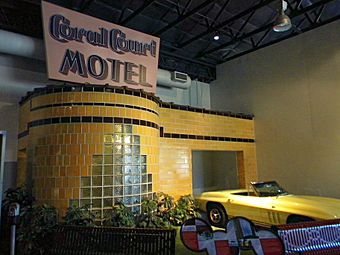 |
|
| Location | Marlborough |
| Nearest city | St. Louis, Missouri |
| Area | 8.5 acres (3.4 ha) |
| Built | 1941 |
| Architectural style | Art deco and streamline moderne |
| Demolished | 1995 |
| NRHP reference No. | 89000311 |
| Added to NRHP | April 25, 1989 |
The Coral Court Motel was a famous motel built in 1941 along U.S. Route 66 in Marlborough, Missouri. This town is a suburb of St. Louis. It was special because it showed off the cool art deco and streamline moderne styles of architecture. In 1989, it was even added to the National Register of Historic Places because it was such a great example of these styles.
At its busiest, the motel grew to have 77 rooms. This was when car tourism on Route 66 was very popular. But after Interstate 44 was built in the 1970s, fewer cars used Route 66. This made business slow down, and the motel closed in 1993. Even though many local people tried to save it, the Coral Court Motel was torn down in 1995 to make way for new houses.
Contents
The Coral Court Motel: A Roadside Legend
The Coral Court Motel was more than just a place to sleep. It was a landmark on America's most famous road, Route 66. It showed how travel changed when cars became popular.
What Was the Coral Court Motel?
The Coral Court Motel was a special kind of motel. It was designed for people traveling by car. Each room often had its own garage, which was very modern for its time. The motel's design was sleek and stylish, using glass brick and ceramic tile. This made it look very futuristic in the 1940s.
A Look Back: Its History
The Coral Court Motel had an interesting journey from its opening to its closing. It saw many changes in how people traveled.
Building a Roadside Gem
John Carr opened the Coral Court Motel in 1942, right when the US was involved in World War II. It started with 20 rooms. These rooms were in ten separate buildings, each with two units. A cool feature was that each unit had its own garage in the middle of the building.
In 1946, the motel added 23 more two-unit cabins, bringing the total to 66 rooms. Later, in 1953, three two-story buildings were added. A swimming pool was also put in during the 1960s, making it an even better place for travelers to stop.
The Rise and Fall of a Popular Stop
U.S. Route 66 was the main highway in the area for many years. Because of this, the Coral Court Motel was very busy. But things changed when Interstate 44 in Missouri was built. This new, faster highway opened at the end of 1972. It took away a lot of traffic from Route 66.
Many businesses along Route 66 struggled after this. However, the Coral Court Motel seemed to stay in good shape until John Carr passed away in 1984.
Why It's Gone (But Not Forgotten)
After John Carr's death, his widow took over the motel. She remarried and continued to run it for a few years. But the buildings started to get old and worn out. By 1988, people worried the motel might be torn down. This was because she had plans to sell the land to builders who wanted to build a shopping mall.
Local groups who wanted to save old buildings formed the Coral Court Preservation Society. They successfully got the motel listed on the National Register of Historic Places. However, being on this list doesn't always stop a private property from being torn down. The motel was in very poor condition after years of neglect. It finally closed in 1993 and was torn down in 1995. Today, a housing development called "Oak Knoll Manor" stands where the motel once was.
Even though most of the motel is gone, one of its original two-unit buildings was saved. Volunteers carefully took it apart. It was then rebuilt as part of a car exhibit at the National Museum of Transportation in St. Louis. This exhibit, built in 2000, includes a 1941 Cadillac and the front of one of the original motel cabins. It helps tell the story of cars and travel from that time. People have also tried to get a historic marker placed at the original site to remember the motel.


